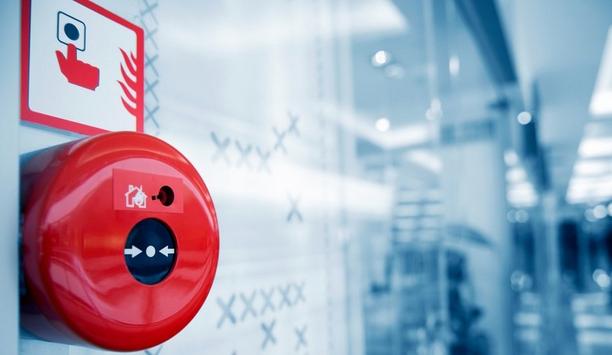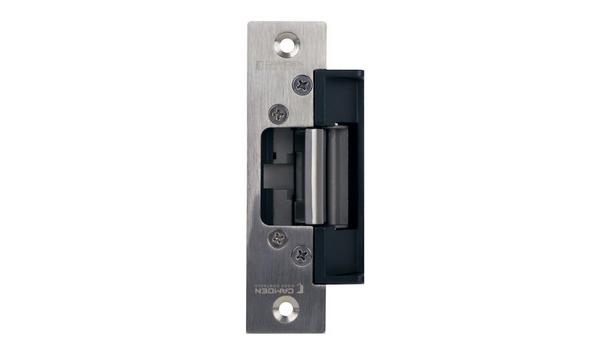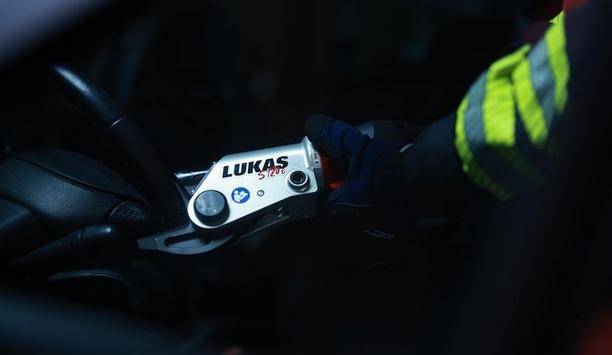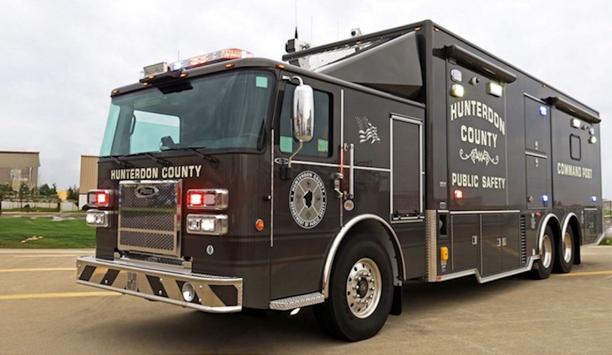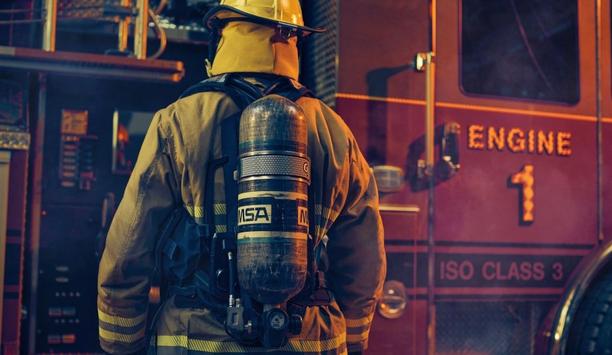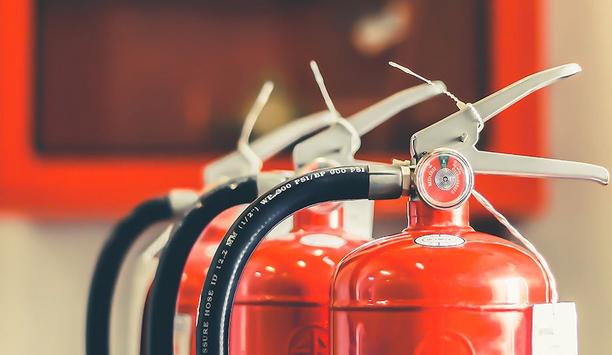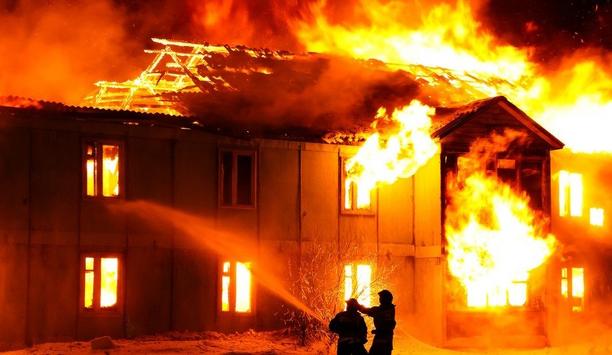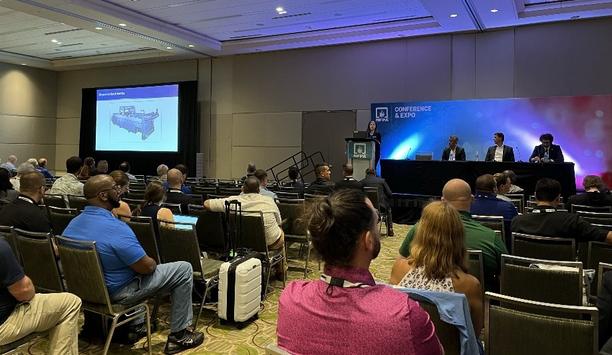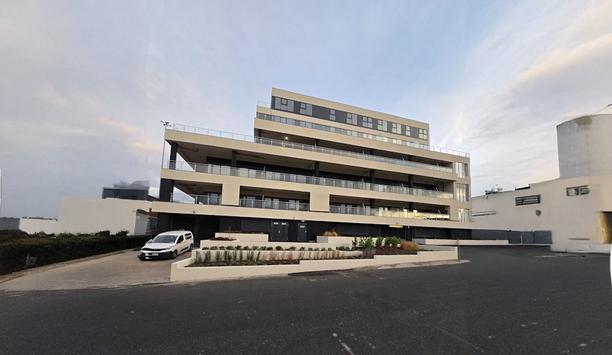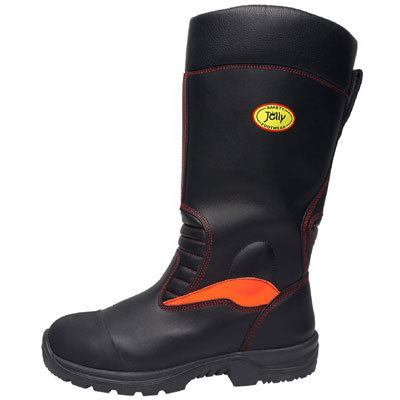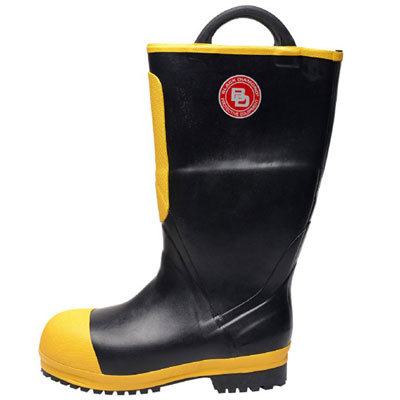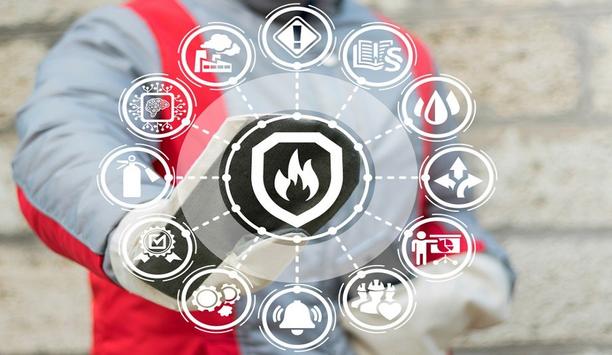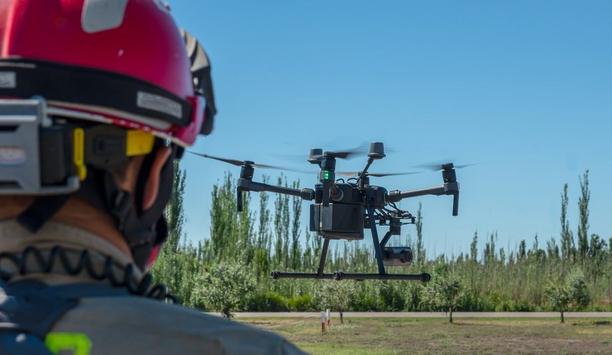Fire Safety Standards
The National Fire Protection Association (NFPA) has developed over 300 codes and standards to support the rapidly changing needs of the fire and life safety industry. NFPA 72, National Fire Alarm and Signaling Code®, is perhaps one of the most wide-ranging, designed to “meet society's changing fire detection, signaling, and emergency communications demands.” Development of building solutions Updated every three years, the 2025 edition of NFPA 72 took effect on September 18, 2...
Darley has just released Firefighting Equipment Catalog #278! Specifically crafted for first responder professionals, this redesigned catalog features over 200 pages of innovative solutions from Darley and the trusted partners, all showcased with dynamic and engaging imagery. The new catalog is also enhanced with more references to the online shopping experience at shop.darley.com, making it easier than ever to quickly find expanded product information and make informed purchasing decisions. D...
Healthcare environments are synonymous with caution, wellness and safety. Though, where National Health Service professionals work determinedly to meet the needs of their patients, equally as vital are the fire door safety procedures practiced throughout NHS premises. Fire safety management plays a crucial role in all healthcare settings, where protecting staff, visitors and potentially vulnerable patients is a continuous effort. Highest level of fire safety A survey led by BWF found that 52%...
Camden Door Controls is proud to announce the launch of its new 1420 Series Low-Profile Fire-Rated Strike, designed to provide a cost-effective solution for code compliance in UL fire-rated doors and frames with cylindrical locksets. Built to the highest industry standards, the CX-ED1420 strikes are Grade 1 ANSI fire-rated and engineered for 1/2” to 5/8” latch projection. CX-ED1420 Series features They offer exceptional durability with 1,500 lbs static strength and are factory-tes...
Lukas Hydraulics is proud to announce the launch of the S120e Power Cut, a compact extrication tool, which enables firefighters to quickly and precisely navigate tight spaces - providing a portable and efficient solution for extricating victims in confined or hard-to-reach areas. Risk of injury process Bulkier tools can be challenging to use in tight spaces due to their size and weight, which limit maneuverability, increase the risk of injury, and delay the rescue process. In such scena...
Renowned integrated fire and security systems business - Evolution has opened its new flagship UK headquarters in Marlow to better serve and support the needs of its clients throughout the region, and beyond. The new state-of-the-art facility, located at Globe House – with quick and easy access to the M4 and M40, will provide a new account management, service, and support base to enable the business to meet and exceed ever-changing client needs with its innovative and technical integrated...
News
AGF Manufacturing is pleased to announce the addition of George Stewart to its growing engineering team. George brings with him a wealth of engineering experience across a diverse range of industries and a strong track record of developing specialized equipment and systems. George began his career at Gamajet/Alfa Laval, where he worked his way up through the engineering department. There, he focused on designing advanced tank cleaning machines and systems used in a wide range of industrial applications. Silicon carbide components George worked with Coherent, where he engineered silicon carbide components for use in space optics George Stewart's career then took him to National Foam, where he specialized in high-flow and high-expansion foam firefighting systems, deepening his expertise in fire protection technologies. Most recently, George worked with Coherent, where he engineered silicon carbide components for use in space optics, contributing to cutting-edge advancements in aerospace technology. “Each step in my career has been a unique experience, and I’ve had the chance to work on some really fascinating and technically challenging projects,” said George Stewart, adding “But I’m especially excited to be here at AGF, where innovation, reliability, and customer-focused solutions are at the core of what we do.” Fire protection industry AGF is thrilled to welcome George Stewart aboard and looks forward to the knowledge and passion he brings to his role. His well-rounded background in mechanical design and systems engineering makes him a valuable asset as AGF continues to expand its product offerings and enhance support for contractors, engineers, and distributors in the fire protection industry.
Darley, in partnership with the National Fallen Firefighters Foundation (NFFF), is proud to announce the launch of the 2025 Fire Service Thought Leadership Essay Contest – Understanding the ‘Why’ Behind Mental Health in the Fire Service. Now in its fourth year, this initiative challenges firefighters nationwide to explore the critical yet often overlooked mental health issues within their ranks. 2025 Fire Service Thought Leadership Essay Contest Competition seeks to uncover the deeper reasons behind firefighters' mental health challenges The competition seeks to uncover the deeper reasons behind firefighters' persistent mental health challenges, beyond the daily high-stakes stress of their lifesaving roles. “Understanding the 'why' behind the mental health crisis is crucial,” said Garry Briese, a Member of the Darley Board of Directors, adding “This competition provides a unique platform for firefighters to voice their experiences and insights, fostering a broader understanding and paving the way for effective solutions.” Focus on introspection and analysis With a focus on introspection and analysis, participants are encouraged to examine various factors contributing to mental health issues, including job stress, firehouse culture, and broader societal impacts that uniquely affect firefighters. The aim is to identify why these challenges not only exist but continue to escalate, especially in the context of rising rates of PTSD, divorce, and suicide within the fire service community. How to Participate: Eligibility: Open to active and retired firefighters, both career and volunteer Essay Requirements: Submit a three- to four-page essay in PDF format, using 12-point Times New Roman font, double-spaced. Submission Period: March 24 – June 2. Call to action for firefighters to express openly “We often hear firefighters say, ‘I’m OK’, masking the true emotional toll of their duties,” said Victor Stagnaro, Chief Executive Officer of the NFFF, adding “This competition is a call to action for firefighters to express themselves openly and contribute to a crucial dialog that can lead to real and lasting change.” Submissions will be peer-reviewed by a panel of fire service and mental health experts, ensuring a comprehensive evaluation of the insights presented.
Frontline Communications, a division of Pierce Manufacturing Inc., an Oshkosh Corporation business, is proud to announce the upcoming delivery of a new Saber® C-40X-4 mobile command vehicle to the Hunterdon County Department of Public Safety in Flemington, New Jersey. This next-generation command vehicle, delivered through Frontline Communications and Pierce Manufacturing dealer Fire and Safety Services, marks a significant milestone in Hunterdon County’s emergency response capabilities and will be prominently displayed at the Fire Department Instructors Conference (FDIC) 2025 in Indianapolis, Indiana, in Pierce Manufacturing’s booth #5337. New mobile command vehicle The new mobile command vehicle is tailored to support emergency management, on-scene operations Designed as a county-wide asset, the new mobile command vehicle is tailored to support emergency management, on-scene operations, SWAT teams, and major disaster response. The unit enhances communication capabilities, providing a mobile dispatch center that supports the workload of Hunterdon County’s communications division during high-demand incidents. Effective emergency response services “This Mobile Command Vehicle is a game-changer for Hunterdon County,” said Brayden Fahey, Public Safety Director/County OEM Coordinator with Hunterdon County Department of Public Safety. “The technology upgrades, additional space, and overall versatility will allow us to provide more efficient and effective emergency response services." "This investment ensures that we are better equipped to handle incidents of any scale, supporting not only our first responders but also the safety of our residents.” Features of Command Zone™ Advanced Electronics System Built on a tandem axle Saber chassis, the command vehicle is powered by a Cummins L9, 450 hp engine and features a Command Zone™ Advanced Electronics System to ensure seamless operational control. At 41’ 3” in length and 13’ 3” in height, the vehicle provides ample space for critical response operations, with advanced technology integration, including: Enhanced communications: A fully integrated dispatch area with upgraded technology, providing real-time coordination for emergency responders. Surveillance and visibility: A Will-Burt Night Scan Light Tower mounted on the roof and a 42’ heavy-duty mast system with IC Realtime HD PTZ camera for extended visibility and intelligence gathering at the rear of the apparatus. Powerful and efficient operation: A Harrison Hydraulic 25 kW generator ensuring reliability in the most demanding environments. Comfort and efficiency: A 20’ 12VDC electric awning for exterior operations and field coordination. Level of service across widespread emergencies Replacing a 24-year-old command unit that previously responded to major incidents—including 9/11 incident response—this new vehicle represents a significant upgrade for the Hunterdon County Department of Public Safety. The unit provides first responders with increased space, versatility, and a higher level of service across widespread emergencies such as natural disasters, multi-agency responses, and tactical law enforcement operations. Modern emergency response The Hunterdon County Board of Commissioners played a vital role in the asset of this new vehicle The Hunterdon County Board of Commissioners played a crucial role in the acquisition of this new vehicle, and a dedicated plaque will be placed on the unit to recognize their contributions and commitment to public safety. FDIC 2025 attendees will have the opportunity to see the Hunterdon County mobile command vehicle firsthand in Pierce Manufacturing’s booth #5337. Frontline Communications and Fire and Safety Services representatives will be available to discuss the vehicle’s capabilities and its impact on modern emergency response. Importance of public safety challenges "This command unit will bring groundbreaking innovation to the region," said Chris Vallat from Fire and Safety Services. “Hunterdon County’s investment in this state-of-the-art command vehicle highlights the importance of staying ahead of evolving public safety challenges. We’re honored to play a part in delivering this critical asset.”
As Taiwan's security industry continues to evolve with technological advancements and increased diversification, various vertical markets are poised for significant growth. Secutech, scheduled for 7–9 May 2025 at the Taipei Nangang Exhibition Center, aims to capitalize on this burgeoning demand. Around 400 international and local exhibitors are set to showcase the latest technologies and solutions across six zones and pavilions at the fair, which serves as a vital platform to connect security and fire safety suppliers with key industry players in Taiwan. Demand for upgrading equipment and systems AIoT landscape is reshaping mixed industries and driving an increasing demand for upgrading kit Recent reports indicate that Taiwan's security market is projected to compound at an annual rate of 6.6%, reaching an estimated USD 119.9 million by 2029. At the same time, the artificial intelligence of things (AIoT) landscape is reshaping various industries and driving an increasing demand for upgrading equipment and systems aimed at improving fire and safety efficiency. Affected settings include hospitals, industrial sites, parking facilities, old buildings, factories, shopping malls, and energy storage facilities. Security and fire safety equipment Exhibitors at Secutech 2025 will be integral to this wave of advanced technology, showcasing the integration of 5G, AI, and IoT in security and fire safety equipment for real-time monitoring, predictive analytics, and automated responses, ensuring higher efficiency and safety across multiple industries. The 26th edition will welcome prominent international brands in the global security landscape, including NetworkOptix, Panasonic, Blazecut Group, and Mabu Valley Outdoor Ltd. Key local exhibitors With Taiwan's longstanding reputation as one of Asia-Pacific’s technological hubs and its expanding influence in high-tech industries, major Taiwanese manufacturers are pivotal players in the global security manufacturing space. At the show, key local exhibitors will feature their advanced technology, including: TDV - Triple Domain Vision Co Ltd will showcase advanced front-end intelligent video analytics to enhance surveillance effectiveness and operational efficiencies. Avadesign Technology Co Ltd will display a comprehensive suite of security monitoring and management services, focusing on IP video intercom and house automation solutions. Formosa Plastics Corporation is set to modernize information chains and applications with smart workplace safety management platforms, facial recognition access controls, electronic fence detection technologies, and security monitoring dashboards. Himax Technologies Ltd will exhibit cutting-edge image processing technologies tailored for security applications, including CMOS sensors, wafer-level optics for AR devices, 3D sensing technologies, and ultralow-power AI image sensing technologies. Vivotek will showcase a range of IP surveillance products and solutions driven by advanced AI algorithms, supported by a one-stop monitoring cloud platform. Marson Technology will present high-quality barcode scanning equipment along with complete OEM/ODM services. Exploring key industry trends for diverse applications This year’s show will feature six zones and pavilions, where key manufacturers will showcase their innovative solutions, aiming to capture critical trends across various vertical industries. These areas create a comprehensive environment for exploring cross-sector sourcing and collaboration opportunities: AI Innovation Application Zone (Transportation / Logistics / Retail) SmartHome and Building Pavilion Security and AIoT Smart Security Pavilion Smart Factory, Industrial Safety and Sanitation Application Pavilion Innovative Fire Prevention and Protection Technology Application Pavilion ESG Total Solution Pavilion Adoption of AIoT drives information security innovations Taiwan’s emphasis on data security grows increasingly critical, evidenced by rule calls to enrich digital security As AIoT evolves alongside the security market, Taiwan’s emphasis on information security grows increasingly critical, evidenced by government calls to enhance digital security and recent information security sector growth forecasts. The upcoming show will also showcase innovative information security technologies from renowned exhibitors, including InfoKeyVault Technology and Infineon Technologies Taiwan, aiming to advance solutions that address emerging threats and enhance data protection across smart manufacturing, smart home technology, and healthcare industries. Secutech sharing insights for fairgoers In this landscape, Secutech serves as an essential platform, facilitating business connections and sharing insights for fairgoers to stay ahead in a dynamic market. Secutech is organized by Messe Frankfurt (HK) Ltd – Taiwan Branch and is part of a global network of Safety, Security, and Fire trade fairs.
The Task Group Domestic Life Safety of Euralarm has issued a new guidance document on fires caused by unattended cooking and how to avoid them. Many residential fires start in the kitchen and/or are related to cooking. In Europe, the Zurich insurance company mentions cooking equipment as first in an overview of common causes of house fires. New guidance document The new guidance document on fires caused by unattended cooking and how to avoid them In the USA, where the NFPA has actively researched home structure fires, reports show cooking to be the leading cause of home fires and fire injuries, as well as the second highest cause of fire deaths and direct property damage. The new guidance document on fires caused by unattended cooking and how to avoid them provides a comprehensive analysis of stove guards as an effective tool to prevent fires in residential environments. Role in mitigating fire risks In this document, the technical functionalities, the role in mitigating fire risks, and the regulatory frameworks governing stove guards across the European Union are examined. The document highlights the growing trend of mandatory adoption in EU member states and outlines the safety, economic, and societal benefits of widespread implementation. This guidance document aims to act as a guiding document for advancing fire safety measures and ensuring their widespread adoption for the benefit of society. Copies of the guidance document can be downloaded from the Euralarm website.
Innovation in the fire service is a continuous journey, where changing customer needs are driving forces in developing the newest safety solutions. For MSA Safety, that means taking the best and making it even better with the latest edition of its market-pioneer self-contained breathing apparatus (SCBA) and designing an all-new turnout jacket. This week at FDIC International, MSA Safety will do just that by announcing the MSA® G1™ SCBA XR Edition and all-new Globe® G-XTREME® PRO Jacket. Fire service safety innovations The G1 SCBA XR Edition and G-XTREME Pro Jacket join the MSA Cairns® 1836 Fire Helmet The G1 SCBA XR Edition and G-XTREME Pro Jacket join the MSA Cairns® 1836 Fire Helmet as a trio of new fire service safety innovations introduced by MSA Safety in just the past year. These build on the growing list of solutions designed to help protect firefighters and enhance safety by assisting with accountability and situational awareness. “Our customers drive our innovation and lead us to design safety solutions that best meet their safety needs,” said Stephanie Sciullo, President of MSA Americas, adding “In the past decade the fire service has evolved, and so has MSA by bringing new safety solutions to the market. As the leader in head-to-toe firefighter protection, we’re committed to helping advance firefighter safety, and we’ll continue to evolve and innovate by designing the next generation of safety equipment.” Radio interface capability Building on 10 years of continuous innovation, the MSA® G1™ SCBA XR Edition is the latest evolution of the G1 SCBA, featuring enhancements to the breathing air regulator and to various soft goods, including the straps, lumbar pad, and emergency and quick-fill pouches. All soft goods are removable for easy cleaning, and all enhancements are backwards-compatible to existing G1 SCBA units. The G1 SCBA XR Edition will be available for order beginning in May. With 15 U.S. patents, the G1 SCBA has a broad range of innovative features to enhance firefighter safety, comfort, situational awareness and operational efficiency, including standard voice amplification and radio interface capability, an advanced electronics platform powered by a single rechargeable battery, and an integrated telemetry solution. Traditional-style fire helmets This new jacket from Globe Manufacturing Company will be available for order later this year The Globe® G-XTREME® PRO Jacket features a unique, three-panel outer shell design that includes a mesh feature in the liner to reduce bulk and help maximize comfort and mobility; a redesigned collar; and new length options to accommodate a wide range of body types and additional flexibility in design specifications. This new jacket from Globe Manufacturing Company will be available for order later this year. MSA will also feature its Cairns® line of fire helmets and FireGrid™ applications platform at FDIC this year. In addition to the Cairns 1836 Fire Helmet, one of lightest traditional-style fire helmets available to meet National Fire Protection Association (NFPA) standards, various traditional and rescue-style helmets will be on display. Designing protective equipment The cloud-connected capabilities of FireGrid will also be highlighted, featuring applications that help to digitize manual tasks and empower firefighters to use available device and personnel data to make more informed decisions on- and off-scene. “Our mission is to help firefighters stay safe and accounted for by designing protective equipment and connected solutions that are consistent and easy to use,” said Bob Apel, MSA Safety Executive Director, Global Fire Service and Digital Experience, adding “We take an integrated approach to developing our safety solutions and work to provide practical, streamlined equipment that elevates firefighter safety.” The MSA Safety booth at FDIC is number 2623. To stay up to date with the latest company happenings at FDIC, visit MSA's FDIC website or follow MSA Fire's Facebook, MSA Fire’s Instagram and company’s LinkedIn pages.
AGF Manufacturing is pleased to announce the addition of George Stewart to its growing engineering team. George brings with him a wealth of engineering experience across a diverse range of industries and a strong track record of developing specialized equipment and systems. George began his career at Gamajet/Alfa Laval, where he worked his way up through the engineering department. There, he focused on designing advanced tank cleaning machines and systems used in a wide range of industrial applications. Silicon carbide components George worked with Coherent, where he engineered silicon carbide components for use in space optics George Stewart's career then took him to National Foam, where he specialized in high-flow and high-expansion foam firefighting systems, deepening his expertise in fire protection technologies. Most recently, George worked with Coherent, where he engineered silicon carbide components for use in space optics, contributing to cutting-edge advancements in aerospace technology. “Each step in my career has been a unique experience, and I’ve had the chance to work on some really fascinating and technically challenging projects,” said George Stewart, adding “But I’m especially excited to be here at AGF, where innovation, reliability, and customer-focused solutions are at the core of what we do.” Fire protection industry AGF is thrilled to welcome George Stewart aboard and looks forward to the knowledge and passion he brings to his role. His well-rounded background in mechanical design and systems engineering makes him a valuable asset as AGF continues to expand its product offerings and enhance support for contractors, engineers, and distributors in the fire protection industry.
Darley, in partnership with the National Fallen Firefighters Foundation (NFFF), is proud to announce the launch of the 2025 Fire Service Thought Leadership Essay Contest – Understanding the ‘Why’ Behind Mental Health in the Fire Service. Now in its fourth year, this initiative challenges firefighters nationwide to explore the critical yet often overlooked mental health issues within their ranks. 2025 Fire Service Thought Leadership Essay Contest Competition seeks to uncover the deeper reasons behind firefighters' mental health challenges The competition seeks to uncover the deeper reasons behind firefighters' persistent mental health challenges, beyond the daily high-stakes stress of their lifesaving roles. “Understanding the 'why' behind the mental health crisis is crucial,” said Garry Briese, a Member of the Darley Board of Directors, adding “This competition provides a unique platform for firefighters to voice their experiences and insights, fostering a broader understanding and paving the way for effective solutions.” Focus on introspection and analysis With a focus on introspection and analysis, participants are encouraged to examine various factors contributing to mental health issues, including job stress, firehouse culture, and broader societal impacts that uniquely affect firefighters. The aim is to identify why these challenges not only exist but continue to escalate, especially in the context of rising rates of PTSD, divorce, and suicide within the fire service community. How to Participate: Eligibility: Open to active and retired firefighters, both career and volunteer Essay Requirements: Submit a three- to four-page essay in PDF format, using 12-point Times New Roman font, double-spaced. Submission Period: March 24 – June 2. Call to action for firefighters to express openly “We often hear firefighters say, ‘I’m OK’, masking the true emotional toll of their duties,” said Victor Stagnaro, Chief Executive Officer of the NFFF, adding “This competition is a call to action for firefighters to express themselves openly and contribute to a crucial dialog that can lead to real and lasting change.” Submissions will be peer-reviewed by a panel of fire service and mental health experts, ensuring a comprehensive evaluation of the insights presented.
Frontline Communications, a division of Pierce Manufacturing Inc., an Oshkosh Corporation business, is proud to announce the upcoming delivery of a new Saber® C-40X-4 mobile command vehicle to the Hunterdon County Department of Public Safety in Flemington, New Jersey. This next-generation command vehicle, delivered through Frontline Communications and Pierce Manufacturing dealer Fire and Safety Services, marks a significant milestone in Hunterdon County’s emergency response capabilities and will be prominently displayed at the Fire Department Instructors Conference (FDIC) 2025 in Indianapolis, Indiana, in Pierce Manufacturing’s booth #5337. New mobile command vehicle The new mobile command vehicle is tailored to support emergency management, on-scene operations Designed as a county-wide asset, the new mobile command vehicle is tailored to support emergency management, on-scene operations, SWAT teams, and major disaster response. The unit enhances communication capabilities, providing a mobile dispatch center that supports the workload of Hunterdon County’s communications division during high-demand incidents. Effective emergency response services “This Mobile Command Vehicle is a game-changer for Hunterdon County,” said Brayden Fahey, Public Safety Director/County OEM Coordinator with Hunterdon County Department of Public Safety. “The technology upgrades, additional space, and overall versatility will allow us to provide more efficient and effective emergency response services." "This investment ensures that we are better equipped to handle incidents of any scale, supporting not only our first responders but also the safety of our residents.” Features of Command Zone™ Advanced Electronics System Built on a tandem axle Saber chassis, the command vehicle is powered by a Cummins L9, 450 hp engine and features a Command Zone™ Advanced Electronics System to ensure seamless operational control. At 41’ 3” in length and 13’ 3” in height, the vehicle provides ample space for critical response operations, with advanced technology integration, including: Enhanced communications: A fully integrated dispatch area with upgraded technology, providing real-time coordination for emergency responders. Surveillance and visibility: A Will-Burt Night Scan Light Tower mounted on the roof and a 42’ heavy-duty mast system with IC Realtime HD PTZ camera for extended visibility and intelligence gathering at the rear of the apparatus. Powerful and efficient operation: A Harrison Hydraulic 25 kW generator ensuring reliability in the most demanding environments. Comfort and efficiency: A 20’ 12VDC electric awning for exterior operations and field coordination. Level of service across widespread emergencies Replacing a 24-year-old command unit that previously responded to major incidents—including 9/11 incident response—this new vehicle represents a significant upgrade for the Hunterdon County Department of Public Safety. The unit provides first responders with increased space, versatility, and a higher level of service across widespread emergencies such as natural disasters, multi-agency responses, and tactical law enforcement operations. Modern emergency response The Hunterdon County Board of Commissioners played a vital role in the asset of this new vehicle The Hunterdon County Board of Commissioners played a crucial role in the acquisition of this new vehicle, and a dedicated plaque will be placed on the unit to recognize their contributions and commitment to public safety. FDIC 2025 attendees will have the opportunity to see the Hunterdon County mobile command vehicle firsthand in Pierce Manufacturing’s booth #5337. Frontline Communications and Fire and Safety Services representatives will be available to discuss the vehicle’s capabilities and its impact on modern emergency response. Importance of public safety challenges "This command unit will bring groundbreaking innovation to the region," said Chris Vallat from Fire and Safety Services. “Hunterdon County’s investment in this state-of-the-art command vehicle highlights the importance of staying ahead of evolving public safety challenges. We’re honored to play a part in delivering this critical asset.”
As Taiwan's security industry continues to evolve with technological advancements and increased diversification, various vertical markets are poised for significant growth. Secutech, scheduled for 7–9 May 2025 at the Taipei Nangang Exhibition Center, aims to capitalize on this burgeoning demand. Around 400 international and local exhibitors are set to showcase the latest technologies and solutions across six zones and pavilions at the fair, which serves as a vital platform to connect security and fire safety suppliers with key industry players in Taiwan. Demand for upgrading equipment and systems AIoT landscape is reshaping mixed industries and driving an increasing demand for upgrading kit Recent reports indicate that Taiwan's security market is projected to compound at an annual rate of 6.6%, reaching an estimated USD 119.9 million by 2029. At the same time, the artificial intelligence of things (AIoT) landscape is reshaping various industries and driving an increasing demand for upgrading equipment and systems aimed at improving fire and safety efficiency. Affected settings include hospitals, industrial sites, parking facilities, old buildings, factories, shopping malls, and energy storage facilities. Security and fire safety equipment Exhibitors at Secutech 2025 will be integral to this wave of advanced technology, showcasing the integration of 5G, AI, and IoT in security and fire safety equipment for real-time monitoring, predictive analytics, and automated responses, ensuring higher efficiency and safety across multiple industries. The 26th edition will welcome prominent international brands in the global security landscape, including NetworkOptix, Panasonic, Blazecut Group, and Mabu Valley Outdoor Ltd. Key local exhibitors With Taiwan's longstanding reputation as one of Asia-Pacific’s technological hubs and its expanding influence in high-tech industries, major Taiwanese manufacturers are pivotal players in the global security manufacturing space. At the show, key local exhibitors will feature their advanced technology, including: TDV - Triple Domain Vision Co Ltd will showcase advanced front-end intelligent video analytics to enhance surveillance effectiveness and operational efficiencies. Avadesign Technology Co Ltd will display a comprehensive suite of security monitoring and management services, focusing on IP video intercom and house automation solutions. Formosa Plastics Corporation is set to modernize information chains and applications with smart workplace safety management platforms, facial recognition access controls, electronic fence detection technologies, and security monitoring dashboards. Himax Technologies Ltd will exhibit cutting-edge image processing technologies tailored for security applications, including CMOS sensors, wafer-level optics for AR devices, 3D sensing technologies, and ultralow-power AI image sensing technologies. Vivotek will showcase a range of IP surveillance products and solutions driven by advanced AI algorithms, supported by a one-stop monitoring cloud platform. Marson Technology will present high-quality barcode scanning equipment along with complete OEM/ODM services. Exploring key industry trends for diverse applications This year’s show will feature six zones and pavilions, where key manufacturers will showcase their innovative solutions, aiming to capture critical trends across various vertical industries. These areas create a comprehensive environment for exploring cross-sector sourcing and collaboration opportunities: AI Innovation Application Zone (Transportation / Logistics / Retail) SmartHome and Building Pavilion Security and AIoT Smart Security Pavilion Smart Factory, Industrial Safety and Sanitation Application Pavilion Innovative Fire Prevention and Protection Technology Application Pavilion ESG Total Solution Pavilion Adoption of AIoT drives information security innovations Taiwan’s emphasis on data security grows increasingly critical, evidenced by rule calls to enrich digital security As AIoT evolves alongside the security market, Taiwan’s emphasis on information security grows increasingly critical, evidenced by government calls to enhance digital security and recent information security sector growth forecasts. The upcoming show will also showcase innovative information security technologies from renowned exhibitors, including InfoKeyVault Technology and Infineon Technologies Taiwan, aiming to advance solutions that address emerging threats and enhance data protection across smart manufacturing, smart home technology, and healthcare industries. Secutech sharing insights for fairgoers In this landscape, Secutech serves as an essential platform, facilitating business connections and sharing insights for fairgoers to stay ahead in a dynamic market. Secutech is organized by Messe Frankfurt (HK) Ltd – Taiwan Branch and is part of a global network of Safety, Security, and Fire trade fairs.
The Task Group Domestic Life Safety of Euralarm has issued a new guidance document on fires caused by unattended cooking and how to avoid them. Many residential fires start in the kitchen and/or are related to cooking. In Europe, the Zurich insurance company mentions cooking equipment as first in an overview of common causes of house fires. New guidance document The new guidance document on fires caused by unattended cooking and how to avoid them In the USA, where the NFPA has actively researched home structure fires, reports show cooking to be the leading cause of home fires and fire injuries, as well as the second highest cause of fire deaths and direct property damage. The new guidance document on fires caused by unattended cooking and how to avoid them provides a comprehensive analysis of stove guards as an effective tool to prevent fires in residential environments. Role in mitigating fire risks In this document, the technical functionalities, the role in mitigating fire risks, and the regulatory frameworks governing stove guards across the European Union are examined. The document highlights the growing trend of mandatory adoption in EU member states and outlines the safety, economic, and societal benefits of widespread implementation. This guidance document aims to act as a guiding document for advancing fire safety measures and ensuring their widespread adoption for the benefit of society. Copies of the guidance document can be downloaded from the Euralarm website.
Innovation in the fire service is a continuous journey, where changing customer needs are driving forces in developing the newest safety solutions. For MSA Safety, that means taking the best and making it even better with the latest edition of its market-pioneer self-contained breathing apparatus (SCBA) and designing an all-new turnout jacket. This week at FDIC International, MSA Safety will do just that by announcing the MSA® G1™ SCBA XR Edition and all-new Globe® G-XTREME® PRO Jacket. Fire service safety innovations The G1 SCBA XR Edition and G-XTREME Pro Jacket join the MSA Cairns® 1836 Fire Helmet The G1 SCBA XR Edition and G-XTREME Pro Jacket join the MSA Cairns® 1836 Fire Helmet as a trio of new fire service safety innovations introduced by MSA Safety in just the past year. These build on the growing list of solutions designed to help protect firefighters and enhance safety by assisting with accountability and situational awareness. “Our customers drive our innovation and lead us to design safety solutions that best meet their safety needs,” said Stephanie Sciullo, President of MSA Americas, adding “In the past decade the fire service has evolved, and so has MSA by bringing new safety solutions to the market. As the leader in head-to-toe firefighter protection, we’re committed to helping advance firefighter safety, and we’ll continue to evolve and innovate by designing the next generation of safety equipment.” Radio interface capability Building on 10 years of continuous innovation, the MSA® G1™ SCBA XR Edition is the latest evolution of the G1 SCBA, featuring enhancements to the breathing air regulator and to various soft goods, including the straps, lumbar pad, and emergency and quick-fill pouches. All soft goods are removable for easy cleaning, and all enhancements are backwards-compatible to existing G1 SCBA units. The G1 SCBA XR Edition will be available for order beginning in May. With 15 U.S. patents, the G1 SCBA has a broad range of innovative features to enhance firefighter safety, comfort, situational awareness and operational efficiency, including standard voice amplification and radio interface capability, an advanced electronics platform powered by a single rechargeable battery, and an integrated telemetry solution. Traditional-style fire helmets This new jacket from Globe Manufacturing Company will be available for order later this year The Globe® G-XTREME® PRO Jacket features a unique, three-panel outer shell design that includes a mesh feature in the liner to reduce bulk and help maximize comfort and mobility; a redesigned collar; and new length options to accommodate a wide range of body types and additional flexibility in design specifications. This new jacket from Globe Manufacturing Company will be available for order later this year. MSA will also feature its Cairns® line of fire helmets and FireGrid™ applications platform at FDIC this year. In addition to the Cairns 1836 Fire Helmet, one of lightest traditional-style fire helmets available to meet National Fire Protection Association (NFPA) standards, various traditional and rescue-style helmets will be on display. Designing protective equipment The cloud-connected capabilities of FireGrid will also be highlighted, featuring applications that help to digitize manual tasks and empower firefighters to use available device and personnel data to make more informed decisions on- and off-scene. “Our mission is to help firefighters stay safe and accounted for by designing protective equipment and connected solutions that are consistent and easy to use,” said Bob Apel, MSA Safety Executive Director, Global Fire Service and Digital Experience, adding “We take an integrated approach to developing our safety solutions and work to provide practical, streamlined equipment that elevates firefighter safety.” The MSA Safety booth at FDIC is number 2623. To stay up to date with the latest company happenings at FDIC, visit MSA's FDIC website or follow MSA Fire's Facebook, MSA Fire’s Instagram and company’s LinkedIn pages.


Expert Commentary
Nearly a decade has passed since the devastating Grenfell Fire, and still the UK construction industry finds itself grappling with the imperative of ensuring fire safety standards in residential buildings. A key issue is the gathering, administration and distribution of up-to-the-minute, whole-life building data; vital information, for safeguarding residents during emergencies. Despite the urgent need, information voids and data deserts continue to plague the built environment. Notably in older properties. These lapses enable the presence of ongoing hazards, endangering occupants, also potentially jeopardizing the careers of anyone involved in the design, construction, and management of the affected buildings. Integrity of building information There has been substantial progress achieved to enhance the integrity of building information In recent years, there has been substantial progress achieved to enhance the integrity of building information. However, the pursuit of Dame Judith Hackitt’s ‘Golden Thread’ remains a marathon, not a sprint. The phrase ‘room for improvement’ seems apt, as a safety-first ethos has yet to filter through to every level of the industry. In fact, the industry needs to get a move on, as the government has made ambitious housebuilding plans the cornerstone for economic growth. Any data deficiencies in new or refurbished projects will be seen as critical setbacks as occupancy must be delayed until all building information is collected. This underlines the urgent need for agreeing standardized, industry-wide data protocols. Enter the indispensable Regulation 38 Introduced under the Building Safety Act 2022, Regulation 38 serves as a critical mechanism to bridge fire safety information gaps at every project phase – from initial planning and design to construction, handover, operation, and maintenance. It meticulously addresses essential elements such as fire suppression systems, evacuation routes, and construction materials. Crucially, it guarantees vital fire safety data is accessible to those responsible for building safety throughout its lifespan. This is more than mere form filling, it’s a vital backstop ensuring critical fire safety information is available for final inspection, before a building’s suitability for occupancy is determined. However, the take-up of Regulation 38 processes is not as widespread as it should be. Despite its significance, many contractors and subcontractors struggle to grasp its importance or incorporate it into their daily operations. Implementation challenges The difficulty in getting developers, contractors and builders to conform to fire safety documentation ideals The difficulty in getting developers, contractors, and builders to conform to fire safety documentation standards essentially boils down to inadequate, inconsistent, and outdated data management processes. Despite the abundance of best practice guidelines, project teams continue to wrestle with disorganized and incomplete records; even these are often scattered and isolated. The continued reliance on paper-based and offline documents further complicates things. You’ve also got to factor in the sheer volume of data that today’s project teams must handle. The data generated from Building Information Modeling (BIM) alone is staggering, leading to potential overload, increased human error, and diminished accuracy. Digital systems and data management processes Outdated technological infrastructures add another layer of complexity, particularly for SMEs lacking the resources to update their digital systems and data management processes. Incompatibility between legacy and contemporary software breeds inefficiencies and increases the likelihood of errors. These interlinked issues inevitably lead to compliance failures, resulting in costly delays and potential financial, legal, and reputational repercussions. However, the good news is that a readily accessible, mainstream solution already exists to ensure seamless compliance with Regulation 38 and beyond. Embracing digital data solutions Fire safety compliance can now be streamlined, with digital solutions applied across the entire building lifecycle In the last decade, digital information management tools have undergone a remarkable evolution. Modern platforms have revolutionized the identification, collection, storage, recovery, and sharing of critical fire safety information. Better still, these digital tools standardize processes through set templates and workflows, enabling instant communication and seamless integration with existing systems. These tools are potential game-changers. Fire safety compliance can now be streamlined, with digital solutions applied across the entire building lifecycle. For instance, contractors can now capture and organize data in real-time during construction, using mobile devices to photograph work, document it, and store it in a centralized cloud-based bank. This once-cumbersome process is now much more user-friendly, and accessible to individuals with varying levels of IT proficiency. As AI and Augmented Reality technologies progress, their likely future integration into these platforms holds the potential to further empower project teams in achieving Regulation 38 compliance with ease. Driving change Turnkey, software-as-a-service (SaaS) solutions, such as PlanRadar, are at the forefront of delivering affordable, regulatory-compliant solutions. What this means, is that now even smaller businesses can access comprehensive solutions without undue financial strain. The impact of all this should stimulate a genuine cultural shift in the construction sector. The objective is to transform industry perceptions of Regulation 38, from a burdensome compliance task to a straightforward safeguard for protecting building occupants. This requires real commitment to sticking to the regulations. The tools are there to help industry comply with the process. It’s now time to pick them up and put them to work.
It is no secret that electricity can have a significant impact on the fire industry, and this is not just something that is restricted to a single country. Daily, we see the devastation that improper electrical wiring and defective products can have on a global scale. Personal injury, property loss, and death can all wreak havoc on those working within the fire service and other first responders, not to mention the significant impact on the entire community where the events take place. steps to minimize electrical incidents There are steps that can be taken to minimize the number of these horrific electrical incidents Research from NFPA® that highlights home electrical fire statistics shows that U.S. fire departments responded to an estimated average of 46,700 home fires involving electrical failure or malfunction each year between 2015 and 2019. An additional 16,390 non-residential electrical fires required a response and were tracked between the years 2012 and 2016, indicating just how burdensome electrical fires are on the fire service. However, there are steps that can be taken to minimize the number of these horrific electrical incidents. The implementation and utilization of current electrical codes and standards is a foundational piece in beginning to minimize these issues from arising. Triad of codes and standards NFPA has a triad of codes and standards that focus on mitigating risk and injury associated with electricity that have become known as the Electrical Cycle of Safety™ (ECoS™). When used collectively and properly, NFPA 70®, National Electrical Code® (NEC®), NFPA 70B, Standard for Electrical Equipment Maintenance, and NFPA 70E®, Standard for Electrical Safety in the Workplace®, provide an alliance for achieving holistic electrical safety. By utilizing the documents that make up the ECoS, businesses and communities can help to mitigate electrical fires and injuries that put significant strain on the limited resources available to the fire service. NFPA has a triad of codes and standards that focus on mitigating risk and injury Electrical Cycle of Safety The Electrical Cycle of Safety starts with an installation that is grounded in the requirements of the NEC The Electrical Cycle of Safety starts with a proper electrical installation that is grounded in the requirements of the NEC. This could be the initial installation for a brand-new building, an addition to an existing building, or new equipment being installed within a building. Regardless of what type of installation is taking place, it is important that, where applicable, proper electrical permits have been filed by the licensed contractor performing the work in the municipality where the building is established. This should then include having the appropriate inspections performed by a qualified electrical inspector throughout each stage of the installation. Having all electrical work done and inspected in accordance with the applicable NEC requirements is the appropriate first step in assuring electrical safety that protects both people and property. Electrical equipment and systems After any installation has been done, electrical equipment and systems must be maintained to ensure that they remain safe for those that service the equipment, as well as those that may be utilizing the equipment, such as production line workers or, in some cases, even the general public. An example of this might be keeping an electric vehicle charger in proper, safe working order so that citizens who need to use it are not exposed to any electrical safety risks, like shock hazards. NFPA 70B provides electrical equipment maintenance requirements and should be used in conjunction with any specific manufacturer maintenance requirements for electrical equipment. Safe working practices Maintaining equipment not only helps ensure electrical safety but it also helps to preserve its reliability Maintaining equipment not only helps ensure electrical safety, but it also helps to preserve its functionality and reliability. In the case of electric vehicle chargers, utilizing Chapter 33 of NFPA 70B can help to establish a maintenance plan for community-based public chargers that will keep them safe and functional for users, while minimizing the need for first responder actions. NFPA 70E is about establishing safe working practices to protect those who engage with electrical systems and equipment while on the job through either installing or servicing them or utilizing the equipment in performing their assigned work tasks. As is well established, there are many risks associated with electricity, such as electrical shock and arc flash incidents, that can put individuals at a significant risk of injury. Safe and healthy working conditions Not only is there a moral obligation as an employer to keep employees safe on the job, but there is often a legal one as well. For example, in the U.S., the Occupational Safety and Health Administration (OSHA) was established with a mission to assure safe and healthy working conditions for working men and women by setting and enforcing standards and by providing training, outreach, education, and assistance. OSHA and NFPA 70E work in harmony to help ensure that employers are providing safe places of employment for their workers. OSHA establishes and enforces its own requirements around how employers must establish electrical safety in their place of business and, in most cases, NFPA 70E provides the means on how to accomplish those requirements. fire service and other first responders First and foremost, it means that the community as a whole becomes safer Together, the ECoS establishes a way in which electrical safety can be provided to communities that minimizes the number of responses that are required of the fire service and other first responders. First and foremost, it means that the community as a whole becomes safer. Furthermore, in a day and age where resources continually become more and more limited, alleviating the need to respond to a higher number of incidents also helps ensure that those valuable resources can be utilized where they are most needed. Knowledge to raise awareness of the ECoS So, how can the ECoS be utilized to help support the fire service and other first responders? As with many things, it begins with gathering knowledge to raise awareness of the ECoS and establish a starting point. Moving forward, this knowledge can be shared with others who have an impact on electrical safety across industries within communities. Understanding the equal importance of safe electrical installations, maintenance, and worker safety in electrical applications will make it easier to have a dialogue with the specific groups or individuals that can impact those areas. Just as the ECoS works in unison to achieve overall electrical safety, it takes everyone working together collectively to do the same.
Safe and seamless movement in our built environment hinges on accurately specified and installed door hardware, explains Russell Marks, managing director of Boss Door Controls. With millions of doors used each and every day, it’s important to recognize the details behind effective access and egress. Whether it’s the regular composite doors found in our homes, the electromechanical access points located in public settings, or the emergency exit fire doors that keep us safe in our work and leisure spaces; door hardware plays an integral role in the safety, security and accessibility of our buildings. Door control components Doorsets are assembled in a variety of configurations, sizes and styles, yet, their operation is always reliant on door control components such as hinges, locks, latches, and door closers. Take fire doors, for example, which are designed to stop the spread of smoke and fire when closed and provide an effective means of escape when open. When operating as intended, a fire door will work in tandem with each of its hardware components, but should one area fail, its fire-resistant capabilities become compromised, leaving a building and its occupants at risk. With that in mind, just how significant is accurate specification and installation? Doorsets are assembled in a variety of configurations, sizes, and styles. Suitable specification Incorrect hardware specification is a common problem associated with building safety. Door controls will directly influence the functionality, accessibility and durability of doors, and as such, it’s essential to understand a building and its user’s needs when choosing between hardware options. Considering factors such as fire safety and inclusive design, specifiers and decision makers are urged to review the door application itself, confirming the chosen hardware meets the required performance ratings, fire ratings, and the latest building standards. Where many buildings require escape routes for example, it is necessary for all doors located on those routes to have suitable exit hardware installed - which is determined by a number of factors including the building’s size and whether it is public facing or not. Incorrect hardware specification is a common problem associated with building safety. Revisions of EN 1125 or EN 179 With occupant safety and legal keeping on the line, it’s clear that specification never undervalued Equally, it is also a legal requirement for all exit devices to comply with the latest revisions of EN 1125 or EN 179 and to possess UKCA and CE markings. With occupant safety and legal compliance on the line, it’s clear that specification should never be undervalued. In fact, by focusing on a project’s requirements as opposed to quick, cost-saving wins, decision-makers can preserve the functionality and safety of buildings whilst adding real value for occupants. Fixing improper installation In many cases, an appropriately specified and perfectly operational door control device can be found ineffective solely as a result of poor installation. Door hardware installation remains a pain point for the fire safety industry specifically, with evidence suggesting that incorrect installation is one of the pioneering causes of fire door failure. Hardware products are often unique to the manufacturer, with distinctive components, fittings and fixing points, and as a result, they should never be approached as like for like installation projects. Instead, during installation, installers must look to follow manufacturer guidelines and fitting instructions. Door hardware installation remains a pain point for the fire industry. Fire door’s integrity With door closers, for example, a fire door’s integrity can quickly become compromised as a result of alignment issues and improper installation methods. Consequently, a fire door may not be able to latch or close fully from its standing position, leaving gaps large enough for smoke and fire to pass through in an emergency situation. Where there is currently no legal framework to assess the competency of installers, it’s important for teams to plan ahead, appreciating that door hardware installation is a specialized task. Fire door’s integrity becomes compromised as a result of alignment issues. Safety standards To further raise safety standards and improve installation accuracy, conscious manufacturers share a wealth of information and detailed walkthroughs in the form of installation templates, product datasheets, and video guides. Additional guidance can usually be found online, with the product packaging, or can be requested directly from the manufacturer. These materials can also be useful post-installation, where teams are required to perform regular maintenance periods as part of their obligations. Conscious manufacturers share a wealth of information. How Allegion UK can help Boss Door Controls is part of the Allegion UK group, known for its wealth of resources designed to help responsible persons, duty holders and professionals undertake product specification, installation and maintenance checks on fire doors and hardware. For accessible fire door hardware support, Allegion’s new ‘Fire Door Hardware Fundamentals’ guide is available for download and combines expert guidance with helpful terminology and useful fire door safety checklists.
Editor's Dispatch
The Dingell Act, signed into law in 2019, has far-reaching implications, including effects on fire management and emergency services. Officially named the John D. Dingell, Jr. Conservation, Management, and Recreation Act, the law impacts fire professionals and their operations and fire prevention strategies. The Dingell Act is a comprehensive public lands bill that touches on various aspects of natural resource management, conservation, and recreation. Fire mitigation efforts One of the key provisions of the act deals with wildfire management, specifically addressing how federal agencies collaborate to prevent and respond to wildfires. The act streamlines fire mitigation efforts, enhances interagency cooperation, and encourages fire prevention measures on public lands. For fire professionals, this means better coordination among federal and local fire services, access to more resources, and improved strategies to combat wildfires. How the Dingell Act Changes Fire Management The act benefits both large fire departments and smaller teams working near public lands The Dingell Act mandates that federal agencies must coordinate with local fire services to develop effective wildfire management plans. This ensures that fire professionals have a direct line to federal resources, which can drastically improve response times. Additionally, the law increases funding for fire prevention initiatives, such as clearing vegetation in high-risk areas. Fire professionals working near national parks and other public lands will find these changes beneficial, as they create more opportunities for proactive fire control. The Dingell Act strengthens fire prevention protocols by prioritizing wildfire risk mitigation in areas under federal jurisdiction. The act benefits both large fire departments and smaller teams working near public lands. Fire professionals should recognize the broad scope of the Dingell Act and understand how it enhances safety measures in their regions. Federal and Local Collaboration Interagency collaboration is one of the key components of the Dingell Act. Fire departments in areas near public lands can now work more closely with federal agencies such as the U.S. Forest Service and the Bureau of Land Management. This collaboration is not limited to wildfire response but extends to training and resource-sharing, which can empower local teams to be better prepared for large-scale fires. By building stronger partnerships, fire professionals can develop more cohesive strategies for fire mitigation and management. The Dingell Act significantly increases the resources available to fire departments, especially in high-risk areas. Through grants and federal funding, fire professionals can access better equipment, training, and personnel to tackle fire hazards. This investment in fire prevention technology, including satellite-based fire detection systems and drones, ensures that teams have the tools they need to act quickly and effectively when fires threaten communities. Environmental Considerations Dingell Act highlights the extent of balancing fire suppression with environmental protection The Dingell Act highlights the importance of balancing fire suppression with environmental preservation. Fire professionals are encouraged to integrate eco-friendly practices into their operations, such as controlled burns that reduce vegetation buildup without damaging ecosystems. Understanding the environmental impact of fire prevention measures is essential for fire professionals who manage lands rich in biodiversity. By aligning fire prevention strategies with conservation goals, professionals can contribute to both safety and sustainability. Along with the increased collaboration between federal and local agencies come more training opportunities for fire professionals than ever before. The Dingell Act opens avenues for specialized training programs that focus on wildfire management and prevention. Firefighters can take advantage of workshops, courses, and simulation-based training to improve their skills in handling large-scale fires. This professional development is especially valuable for those looking to expand their capabilities in the face of growing wildfire risks. Future Considerations Looking ahead, fire professionals should be mindful of the evolving landscape of fire prevention. The Dingell Act represents just one piece of a broader legislative push to improve fire safety in the United States. Future regulations may build on this foundation, with more emphasis on climate change, land management, and fire technology. As professionals assess their current strategies, it is important to stay informed about upcoming changes and ensure that fire prevention efforts are aligned with national standards and policies. {##Poll1728377023 - What is the most critical resource for effective wildfire management?##}
The integration of technology into the fire service has significantly enhanced operations, but it has also introduced new vulnerabilities. Cybersecurity has become a concern for fire departments, possibly impacting their ability to respond effectively to emergencies and protect communities. Potential problems emanating from cybersecurity concerns include a disruption of a community’s emergency response system. False alarms could result from malicious computer hackers manipulating fire alarm systems, thus wasting resources, and causing potential danger for firefighters. Fire Risks From A Cyber-Attack Medical devices are connected to the IoT and are therefore vulnerable to attack Communication is another vulnerability: A cyber-attack on communication systems could hinder coordination among firefighters and with other emergency services. Potential cybersecurity targets related to the fire service include 911 systems, public safety radios, computer-aided dispatch systems, mobile data computers, and phone systems. In the EMS arena, electronic patient reporting and records management systems are at risk. Medical devices are connected to the Internet of Things (IoT) and are therefore vulnerable to attack. Many firefighter tools are operated by computers, so equipment malfunction is a real possibility. The digital world continues to infiltrate almost every aspect of firefighting. Critical equipment, such as fire trucks and rescue tools could be compromised, resulting in longer response times. Vulnerability to Ransomware Attacks Ransomware is a pernicious type of cyber-attack, involving the use of malicious software (malware) that encrypts files, rendering them inaccessible. The attackers then demand a ransom payment in exchange for the decryption key to restore the data. The city of Leeds, Ala., was hit by a ransomware attack in February 2018 that locked all city computers and data, including fire and police departments. A month later, Atlanta’s municipal systems were attacked, resulting in widespread outages, and disrupting city services. Impact on Data Loss and Privacy Fire units handle sensitive data, including the personal data of citizens and crisis responders In addition to operational concerns, there are also possible cybersecurity consequences relating to data loss and privacy. Fire departments handle sensitive data, including the personal information of citizens and emergency responders. A breach could lead to identity theft and reputational damage. On a more intangible level, a cyber-attack could erode public trust in the fire department's ability to protect the community. Negative publicity from a data breach can harm the fire department's image. Phishing schemes Among the cybersecurity threats are phishing schemes, which involve scammers attempting to obtain sensitive information from individuals, usually via email, by disguising themselves as trustworthy entities. Phishing can take the form of fake emails or websites that mimic legitimate businesses like banks, online retailers, or social media platforms. They lure victims by offering enticing deals, creating a sense of urgency, or claiming there's a problem with an account. Once the user clicks on a malicious link or provides personal information, the scammers can steal login credentials, credit card numbers, or other sensitive data. Top motivators of cyber-attacks Malicious files can be delivered as email attachments, which can contain viruses, ransomware, or other malware. Clicking a link in a suspicious email can redirect the user to a malicious website that can download malware or steal personal information. One of the top motivators of cyber-attacks is to collect personally identifiable information (PII) One of the top motivators of cyber-attacks is to collect personally identifiable information (PII), which is any data that can be used to identify an individual. This information includes name, address, phone number, social security or driver's license number, medical records, credit card or bank account numbers, and biometric data, such as fingerprints or facial images. The fire service handles a lot of PII, especially in emergency situations, including incident reports, property records, or patient information related to emergency medical services (EMS). Cyber-Criminals Have a Variety of Profiles Cyber-criminals come from a range of backgrounds and motivations. Individual hackers might be motivated by financial gain, ideology, or simply by the concept of a personal challenge. Organized crime groups might be motivated by profit, power, and/or influence. Other cyber-crime perpetrators include nation-state actors, who might be pursuing espionage, sabotage, or political influence. These threats have significant financial and technical capabilities. They include advanced persistent threats (APTs) from countries like China, Russia, and North Korea. Cyber threats posed by 'hacktivists' So-called 'hacktivists' can be motivated by political or social causes to launch distributed denial of service (DDoS) attacks, website defacement and/or data leaks. There is also the possibility of cyber-terrorists seeking to cause mass disruption or to achieve political or ideological goals. They are capable of large-scale attacks on critical infrastructure. Increased cyber-risks may lead to higher insurance premiums for fire departments There is a cost component of protecting against cybersecurity threats, a critical financial implication for cash-strapped fire departments. Implementing robust cybersecurity measures requires significant financial resources. At the other extreme, responding to a cyber-attack can be expensive, including legal fees, public relations, and system recovery. Increased cyber-risks may lead to higher insurance premiums for fire departments. Mitigation Strategies at a Glance Here are some mitigation strategies fire departments should consider: Risk assessment: Identify vulnerabilities and prioritize mitigation efforts. Employee training: Educate firefighters about cybersecurity best practices. Network security: Implement strong network security measures, including firewalls and intrusion detection systems. Data protection: Regularly back up data and encrypt sensitive information. Data minimization: Collect only the personal data that is necessary, and then limit access. Incident response plan: Develop a comprehensive plan for responding to cyber-attacks. Contingency: Create a backup plan to mitigate risk and minimize loss of critical assets in the event of an attack. Compliance: Ensure adherence with relevant privacy laws such as HIPAA and GDPR. Collaboration: Work with other agencies and cybersecurity experts to share information and best practices.
Thousands of industry professionals gathered at the 2024 NFPA Conference and Expo in Orlando in June. The event brought together educational sessions, networking opportunities, and an exhibitor showcase. NFPA is the National Fire Protection Association. The NFPA annual meeting allowed members and the public to discuss and vote on proposed changes to fire codes and standards. “It’s a gathering place for people in the industry,” says Dr. Rodger Reiswig, Vice President of Industry Relations at Johnson Controls. “You can walk around the floor and observe the trends, see what people are talking about, and view industry trends through a clear set of eyes.” New Foundation Series As vice president of industry relations, Reiswig acts as Johnson Controls’ liaison with the NFPA, works with NFPA technology committees, and serves on the Standards Council that oversees more than 300 NFPA codes and standards documents. Foundation Series is a complete family of fire alarm control units and peripheral devices At the NFPA Conference and Expo in Orlando, Johnson Controls provided “spotlight” seminars at their exhibit booth and highlighted products and services including interactive tools, inspections, remote services, restaurant systems, and the new Foundation Series Fire Safety Solution for the protection of small to mid-size buildings. The Foundation Series is a complete family of fire alarm control units and peripheral devices. NFPA’s codes and standards In addition, Reiswig attended seminars and Standards Council sessions. Technical sessions covered codes and standards that are currently “in cycle” (i.e., in the process of being updated). In a technical session on the last day of NFPA, anyone could attend to suggest changes and garner support from others on various changes. Consensus is a core principle of NFPA’s codes and standards. “This is a chance for everyone to participate, whether your interest is in roofing materials, how buildings are built, or life safety systems,” Reiswig adds. “Codes tell us when to do something, but standards tell us how to do it. If the occupancy standard says put in a fire alarm, the NFPA standard tells you how to do that.” Anyone at any level in any role or discipline can participate. new NFPA 915 Standard Fire alarm and life safety have yet lagged industry sectors when it comes to remote connectivity “Technology is changing rapidly, and the type of construction is different than 20 or 30 years ago. Use of new tools and materials in buildings is changing how much time I have to escape smoke or fire,” Reiswig says. “New construction materials allow fires to happen quickly, spread faster, and give off toxic chemicals. Tighter buildings ensure energy efficiency, but they allow less ventilation, so carbon monoxide can accumulate faster.” A common theme at the show was remote connectivity, highlighting the new NFPA 915 Standard for Remote Inspections, which guides new technologies to enable remote access and testing of life safety systems. Fire alarm and life safety have previously lagged other industry sectors when it comes to remote connectivity, but the new NFPA 915 standard opens new possibilities, and vendors at the show were promoting remote capabilities and inspections. develop safeguards and capabilities NFPA 915 Standard sets need for performing remote inspections safely and effectively The NFPA 915 Standard establishes requirements for performing remote inspections safely and effectively. It addresses various types of remote inspections. The standard also defines the responsibilities of various parties involved in a remote inspection, such as the inspector, property owner, and authority having jurisdiction (AHJ). The standard covers data collection procedures, data security, and data ownership. Overall, the standard helps to ensure that remote inspections can be conducted in a way that meets safety requirements. In effect, NFPA 915 gives the green light to manufacturers and Underwriters Laboratories (UL) to develop safeguards and capabilities to log into life safety systems remotely. The approach can help to simplify inspections, which can be performed remotely or with only one technician required on-site rather than two. Requirements include how systems communicate, the cybersecurity and credentials required, and the prevention of outside connections. Beyond fire alarms, the standard also allows other remote inspections, such as using a drone in a large warehouse to inspect sprinkler heads. Real-time information and instructions Inspectors are not allowed into buildings such as nursing homes and clinics to check their safety systems NFPA 915 was being considered before the COVID pandemic, but the business shutdowns and social distancing requirements during the worst of the pandemic increased awareness of the needs and benefits of remote inspections. During COVID, inspectors were not allowed into buildings such as nursing homes and hospitals to inspect their life safety systems. Remote access and inspections became critical, thus raising awareness of the feasibility of remote inspections that continue to drive their adoption. Another area of interest in NFPA was mass notification systems, which have matured a lot since they were introduced into the NFPA code in 2007. It’s easier than ever to provide real-time information and instructions to people in an area. Connectivity among fire alarm systems inside buildings, digital signage, and other life safety systems are promoting better notification. Area of refuge systems A new area of discussion and product development is “area of refuge” systems that complement Americans with Disabilities (ADA) requirements in buildings. In a high-rise building, for example, if the elevators are disabled, it may be impossible for a person using a wheelchair to evacuate. Instead, there are designated “areas of refuge,” which are rated to provide two hours of protection from fire. New notification systems can communicate with first responders about occupants in these areas. The NFPA conference increasingly incorporates a global presence, encouraging more collaboration among entities, countries, and associations about needs around the world. Manufacturers can work together through various associations including the Automatic Fire Alarm Association, Euralarm in Europe, and others. “Life safety is worldwide, and fires may be the same or different in various areas,” says Reiswig. “We need to remember that standards are not just for the United States because people are active from other countries.”
Case studies
When the George and Abbotsford Hotel in Melrose urgently required an upgrade to its existing fire alarm system, Safe Services installed a new Advanced MxPro 5 analog addressable fire panel to provide industry-pioneering protection. George and Abbotsford Hotel The George and Abbotsford Hotel is located a 5-minute walk from the historic St Cuthbert's Way and Melrose Abbey in the Scottish Borders. A popular, busy hotel it attracts guests who are keen to walk in the footsteps of St Cuthbert across the unspoiled countryside, as well as visit ancient market towns, and local historic sites, such as Abbotsford the home of Sir Walter Scott. With guest and staff safety of paramount importance, the hotel needed an upgrade to its existing fire alarm system to bring it up to Category L2 coverage standards as the current system was obsolete and was starting to fail. upgrade the fire system The Advanced panel was also seamlessly integrated with EMS Firecell wireless devices Fire and security service providers, Safe Services, were contacted to upgrade the fire system and installed an Advanced MxPro 5 four-loop analog addressable fire panel, with all four loops used to meet the requirements of this large hotel. The Advanced panel was also seamlessly integrated with EMS Firecell wireless devices. Due to the size of the hotel, it would have been impossible to install cabling because of the extensive downtime that would be needed to fit the cables. The fire system was also interfaced with a kitchen suppression system to provide extra protection. MxPro 5 four-loop analog panel “We are very happy with the Advanced system and the installation by Safe Services. It was quite a complex project as the hotel is a big building,” said Graham Barrett, Owner of the George and Abbotsford Hotel. "The previous fire safety system was obsolete, it was a cabled system and the cables were obsolete too. It would have been very costly to install a cabled system as it was so complex. We decided on a radio system and that took a week to install." design and installation Graeme Millar, Fire Technical Sales Engineer at Safe Systems, said, “The George and Abbotsford Hotel required a new fire alarm system to meet Category L2. Housed in a large building, both the fire alarm system and cabling were obsolete." "However, installing new cabling would have meant major disruption to this busy hotel due to the building’s size. We therefore integrated the Advanced panel with the wireless EMS Firecell. The Advanced MxPro 5 is our panel of choice as it’s a trusted and reliable panel with our design and installation teams. Combining the Advanced MxPro 5 with the EMS equipment works very well and we have used this combination in a number of our projects.” robust protection and compliance Neil Parkin, Sales Manager at Advanced, said, “In hotels, it is vital to ensure fire alarm systems meet the latest standards and so protect guests and staff." "Our MxPro 5 panels are designed to make life as easy as possible, delivering robust protection and compliance that offers real peace of mind, all backed up by our highly rated technical support. Selecting wireless equipment when installing a fire system offers minimal disruption for hotels providing both time and cost benefits.” multiprotocol fire panel MxPro 5 can be used in single-loop, single-panel format, or easily configured into high-speed networks MxPro 5 is the fire industry’s pioneering multiprotocol fire panel and is certified by FM Approvals to the EN 54 standard. It offers customers a choice of four detector protocols and a completely open installer network, backed up by free training and support. MxPro 5 can be used in single-loop, single-panel format, or easily configured into high-speed networks of up to 200 panels covering huge areas. Ease of installation and configuration, as well as its wide range of peripheral options, make MxPro 5 customizable to almost any application. versatile wireless capabilities As well as compatibility with wired detector brands, MxPro 5’s versatile wireless capabilities make it easy to install robust fire alarm systems whilst saving crucial time, cost, and disruption. Harnessing the power of proven technology, MxPro 5’s wireless solutions are scalable, adaptable, and reliable – for complete fire safety and peace of mind. two-way communication Wireless solutions not only mean lower visual and physical impact, but they are also faster and cheaper to install, making them an increasingly popular alternative for sites where downtime is not an option, or re-wiring would prove disruptive. Due to two-way communication with the panel, battery replacement, and fault reporting can also be worked into the ongoing maintenance schedule via the panel service tools. false alarm management capabilities AlarmCalm delivers unprecedented control of verification and investigation delays The MxPro 5’s stand-out false alarm management capabilities are available as standard and are ideal in hotel applications. AlarmCalm delivers unprecedented control of verification and investigation delays. By dividing sites up into virtual false alarm ‘building areas’ independent of fire zones, much more precise control of false alarm management and reduction strategies can be achieved that exactly fit the needs of each part of a building. intelligent fire systems An optional AlarmCalm button allows trained occupants to verify if they believe a local fire signal is a false alarm too – a highly effective way of eliminating unwanted alarms. As a world pioneer in the development and manufacture of intelligent fire systems, Advanced products are specified in locations around the world, from single-panel installations to large, multi-site networks. Advanced portfolio The Advanced portfolio includes complete fire detection systems, multiprotocol fire panels, extinguishing control, false alarm management, and reduction systems. Advanced is owned by FTSE 100 company Halma PLC – a global group of life-saving technology companies with a clear purpose to grow a safer, cleaner, healthier future for everyone, every day.
A prestigious store that redefines luxury shopping in Edinburgh reopens with a brand new Hochiki fire detection system. Multrees Walk, in the heart of St James’ Quarter, a prestigious shopping destination in Edinburgh, offers a curated selection of high-end brands and premium shopping experiences. Earlier this year, the retail center witnessed an extension to a prestigious store that redefines luxury shopping in Edinburgh. As the revamped store prepared to open its doors, a critical element of its infrastructure was installed: a state-of-the-art fire detection system from Hochiki Europe. Discreet fire detection systems High-end luxury retailers prioritize discreet fire detection systems to keep the brand's esthetic appeal High-end luxury retailers prioritize discreet fire detection systems to maintain their brand's esthetic appeal. These stores often feature meticulously designed interiors with clean lines and minimal distractions, meaning any visible fire detection devices can disrupt the desired ambiance and detract from the overall shopping experience. By opting for discreet systems, these retailers ensure that fire safety remains a top priority without compromising the store's luxurious atmosphere. Fire manufacturer's ESP range With its stunning interior design and exquisite collection of accessories and ready-to-wear items, this new store in Edinburgh, demanded a fire safety solution that was both discreet and highly effective. GB Integrated Systems (GBIS), specialize in providing fire detection and security system solutions for commercial properties. Having worked with Hochiki products for several years, trusting their reliability in retail environments, they knew the global fire manufacturer's ESP range would provide the perfect answer. Highest standards in fire safety design Mike Gray, Technical Director from GBIS told us: “We chose Hochiki as it offered a comprehensive solution for this project with a broad selection of devices, including smoke detectors, heat detectors, manual call points, base sounders and air sampling system.” The project comprised over 40 analog addressable devices and a sophisticated air sampling system, ensuring the highest standards in fire safety design. The air sampling system, seamlessly integrated into the fire detection loop, was a crucial component of the installation. Actual fire hazards Air sampling enables precise detection in hard-to-reach areas like ceiling voids, ensuring a wide range Air sampling enables precise detection in hard-to-reach areas like ceiling voids, ensuring comprehensive coverage throughout a retail environment. The Hochiki devices respond accurately to real fire conditions while minimizing false alarms through multi-sensor technology, environmental adjustments, and filtering mechanisms. With these features, the team at GBIS could reassure the luxury retailer that the fire alarm system could effectively differentiate between non-threatening signals and actual fire hazards, thereby improving safety, reducing false alarms, and enhancing operational efficiency within the store. Interfacing the fire alarm system A key challenge was interfacing the fire alarm system with the shopping center's security control center. This complex integration required careful planning and execution to ensure that the system would respond appropriately to different fire scenarios. In the event of a fire within the store, the system would trigger specific alarms and notifications, while a fire in the shopping center would activate different alerts, minimizing disruption to the store's operations. Innovative fire safety A key challenge was interfacing the fire alarm system with the shopping center's security center Gray added: “Installing the fire alarm system in this premium, high-end retail space is especially exciting because it brings innovative fire safety and sophisticated technology into a luxurious environment where safety and customer experience are paramount." "The precision and reliability of our install aligns perfectly with the retail brand’s high standards, protecting valuable merchandise, ensuring shopper safety, and minimizing disruptions from false alarms." Hochiki ESP range Gray added: "With hidden devices and seamless integration, the Hochiki ESP range not only safeguards the premises but also maintains the esthetics, adding a layer of security that complements the brand’s reputation for excellence and customer care." "It’s very satisfying to see the finished Hochiki install in premises of this nature and instills a great sense of pride in the work we do.” Hochiki's fire detection solutions This successful project showcases the power of Hochiki's fire detection solutions to protect high-end retail environments. By combining innovation, reliability, and esthetic appeal, Hochiki has helped to create a safe and secure space for customers to indulge in the ultimate luxury shopping experience.
CED Fire Protection was engaged to carry out the dry fire protection to this 4-level 6,200 sqm self-storage facility, which ran for 11 months; the total build cost was a 7.3 million dollar building located in Williamstown. As part of the work, they installed a Pertronic’s FIP fire indicator panel with BOWS building occupancy system, smoke and heat detection was installed, as well as integrating control to sprinklers, security, and mechanical services.
Hochiki Europe, a globally renowned manufacturer of innovative life safety solutions, is pleased to announce that its ESP intelligent fire detection range has been installed at a brand new 17,000 square meter storage hub near Galanta, Slovakia. The extensive warehouse facility, owned by KL Logistic, presented a significant fire safety undertaking due to its sheer size and the diverse range of goods stored within its 18-meter high racking. Hochiki’s advanced ESP range KL Logistic assigned the project to Pro Metheus Slovakia, a worthy Slovakian fire safety specialist Recognising the critical need for a swift and dependable detection and evacuation system, KL Logistic entrusted the project to Pro Metheus Slovakia, a respected Slovakian fire safety specialist. Pro Metheus Slovakia designed and installed a comprehensive fire safety solution centered around Hochiki Europe’s advanced ESP (Enhanced System Protocol) range. Hochiki’s FIRElink aspirating smoke detection system Hundreds of Hochiki ESP optical smoke detectors were strategically positioned throughout the vast building, providing crucial early fire warning capabilities. To ensure complete protection, particularly within the dense racking, Hochiki’s FIRElink aspirating smoke detection system was also implemented, safeguarding even the most inaccessible areas. Hochiki’s ESP protocol Networked Hochiki HFP control panels serve as the central monitoring and control hub The entire Hochiki system is seamlessly networked via Hochiki’s ESP protocol. Networked Hochiki HFP control panels serve as the central monitoring and control hub, while ESP input and output modules facilitate seamless integration with the warehouse’s sprinkler system. This integrated approach guarantees a fully coordinated response in the event of a fire. Furthermore, the system incorporates a voice evacuation system. This, combined with the rapid detection capabilities of the Hochiki system, ensures the safe and efficient evacuation of all warehouse personnel in any emergency. Scale and complexity of the KL Logistic “The scale and complexity of the KL Logistic warehouse demanded a fire detection system that was both powerful and dependable,” commented Tibor Lelkes, CEO of Pro Metheus Fire. Tibor Lelkes adds, “Hochiki’s comprehensive product portfolio, coupled with their sophisticated networking capabilities, enabled us to design a solution that precisely met the client's specific requirements. The inclusion of the voice evacuation system was a key factor in providing KL Logistics with complete peace of mind. We are proud to have delivered a system that significantly enhances the safety of their employees and protects their valuable assets.”
Lucent Square, a new residential development in Leeds, has been equipped with Advanced’s EvacGo evacuation alert system to enhance resident safety and ensure compliance with the BS 8629 Code of Practice. Covering 54 apartments across six floors, the system features a standalone EvacGo panel located at the main entrance and provides fire and rescue services with a reliable method of alerting residents in an emergency. Installation of evacuation alert system Installation of an evacuation alert system was a key requirement to ensure the highest levels of safety As part of the fire strategy for the development, the installation of an evacuation alert system was a key requirement to ensure the highest levels of safety. S&R Electrical Contracting Services Ltd, responsible for the full installation, selected Advanced’s EvacGo system due to its compliance with BS 8629 and its reputation for reliability. This is the first time the team has installed EvacGo, and, following the completion of this project, they now highly recommended it based on their experience. Fire and rescue service As with all EvacGo systems, the panel at Lucent Square is housed inside a secure STS 205-certified enclosure with a BS EN 1303-compliant lock and key mechanism, ensuring that only the fire and rescue service can access the controls. This minimises the risk of tampering while guaranteeing that evacuation procedures can be implemented efficiently when needed. Steve Greenwood, Director at S&R Electrical Contracting Services Ltd, said: “This was our first installation of an EvacGo system, and we were very impressed with its ease of use and straightforward setup. Advanced’s reputation in the industry gave us full confidence in specifying their system for this project, and it has proven to be a great choice.” Key safety measures for residential buildings The installation of EvacGo at Lucent Square reflects the growing commitment to ensuring resident safety Shaun Scott, Emergency Evacuation Systems Application Engineer at Advanced, said: “We are pleased that our EvacGo system has been chosen for Lucent Square, providing an essential layer of safety for its residents." "Evacuation alert systems are becoming increasingly recognised as a key safety measure for residential buildings, and it’s encouraging to see developers prioritising solutions that adhere to best practice.” EvacGo regulatory requirements The installation of EvacGo at Lucent Square reflects the growing commitment to ensuring resident safety in high-rise buildings. With evacuation alert systems now mandatory for new residential buildings over 18 metres in England and Scotland, developers and installers are increasingly turning to trusted, compliant solutions such as EvacGo to meet regulatory requirements and provide peace of mind to residents and building managers alike. Advanced evacuation alert systems BS 8629 guidance states that the evacuation alert control system should be installed All Advanced evacuation alert systems are custom manufactured to reflect each individual building’s evacuation zones and have been developed to provide a bespoke solution that allows the fire services to control evacuation floor by floor according to the severity and location of the fire. BS 8629 guidance states that the evacuation alert control system should be installed where a ‘stay put’ policy is in force, so that it can be used to facilitate a timely and ordered evacuation for all residents. Fire safety for the occupants of high-rise residential buildings By making it easier and safer for firefighters to inform residents of a change in evacuation strategy during an incident, evacuation alert systems are helping to transform fire safety for the occupants of high-rise residential buildings across Britain. A dvanced holds regular CPDs on BS 8629 to help improve understanding of the Code of Practice and how/where it should be applied.
FLIR thermal cameras are proven performers in the early identification of hotspots that emerge when common equipment found in food processing plants deteriorates, wears or reaches end-of-life. Established in 1997, Dovecote Park supplies British beef, veal and venison to retail, fine dining and food service customers nationwide. Committed to keeping its workforce safe and its productivity rates high, Dovecote Park urgently began to assess potential solutions. Identification of a potential fire risk The move was prompted by the identification of a potential fire risk in the company’s production The move was prompted by the identification of a potential fire risk in the company’s production hall roof voids, which house devices such as motors, pumps, electrical cabinets and distribution boards that power machinery on the food-grade factory floor below. Mechanical problems like worn pumps or damaged bearings, or electrical problems like failing circuit breakers, promote heat accumulation. If this heat goes unnoticed, it could prove the start of a potentially devastating fire. Proactive operating concept Dismissing sprinklers due to their cost and reactive rather proactive operating concept, Dovecote Park was drawn to thermal imaging, a trusted, non-contact way of preventing fires by detecting hotspots before they reach ignition temperature. The company turned to system integrator WRS Solutions, which had previously concluded other successful projects with official FLIR partner, Business Insight 3 (Bi3). Bi3 proposed the installation of multiple FLIR FH-Series R cameras in the roof voids. Early fire detection and visual verification FH-R sensors support the adjustment of threshold temperatures to a specific kit that requires monitoring The FLIR FH-R is a rugged multispectral fixed sensor that combines a thermal radiometric stream with a 4K visible camera to provide rapid, early fire detection and visual verification of the incident as it unfolds. Upon exceeding a hotspot or predefined temperature threshold, security operatives receive an audio/visual alert through a connected Video Management System (VMS), prompting response tactics. Importantly, FH-R sensors support the adjustment of threshold temperatures to specific equipment that requires monitoring. Integrate thermal detection To seamlessly integrate thermal detection with the existing VMS, Bi3 developed custom software using their proprietary data engine. This innovation ensures that alerts are instantly relayed to the engineering department and Nick Dunn, Dovecote Park’s Health, Safety, and Environmental Manager. “FLIR thermal cameras provide peace of mind because we can now be proactive in our equipment maintenance, instead of reactive,” he says. “From the moment something gets hot, our maintenance team can attend to it.” Identification by a FLIR camera Without a label by a FLIR camera, a hot motor bearing could have led to disaster and severe firm disruption Now, Dovecote Hall’s roof voids house over 30 FLIR FH-R thermal imaging cameras. Just 12 months after installation, the cameras have already detected two incidents, one of which was potentially catastrophic. Without identification by a FLIR camera, a hot motor bearing could have led to disaster and serious business disruption. “It’s safe to say that our investment in thermal imaging cameras has already paid for itself,” states Nick Dunn. FLIR technology Robert Groom, Sales Manager at FLIR, adds: “This is a fine example of where proven FLIR technology in the hands of skilled and experienced industry professionals not only protects people and property but also delivers a real return on investment.” Chris Eccles, Sales Director at Business Insight 3 (Bi3) adds: “Successfully delivering this innovative solution necessitates a capable team, and with WRS and FLIR as partners on this project, a seamless installation and integration were achieved. This, resulting in immediate and tangible benefits for Dovecote Park.”
When the George and Abbotsford Hotel in Melrose urgently required an upgrade to its existing fire alarm system, Safe Services installed a new Advanced MxPro 5 analog addressable fire panel to provide industry-pioneering protection. George and Abbotsford Hotel The George and Abbotsford Hotel is located a 5-minute walk from the historic St Cuthbert's Way and Melrose Abbey in the Scottish Borders. A popular, busy hotel it attracts guests who are keen to walk in the footsteps of St Cuthbert across the unspoiled countryside, as well as visit ancient market towns, and local historic sites, such as Abbotsford the home of Sir Walter Scott. With guest and staff safety of paramount importance, the hotel needed an upgrade to its existing fire alarm system to bring it up to Category L2 coverage standards as the current system was obsolete and was starting to fail. upgrade the fire system The Advanced panel was also seamlessly integrated with EMS Firecell wireless devices Fire and security service providers, Safe Services, were contacted to upgrade the fire system and installed an Advanced MxPro 5 four-loop analog addressable fire panel, with all four loops used to meet the requirements of this large hotel. The Advanced panel was also seamlessly integrated with EMS Firecell wireless devices. Due to the size of the hotel, it would have been impossible to install cabling because of the extensive downtime that would be needed to fit the cables. The fire system was also interfaced with a kitchen suppression system to provide extra protection. MxPro 5 four-loop analog panel “We are very happy with the Advanced system and the installation by Safe Services. It was quite a complex project as the hotel is a big building,” said Graham Barrett, Owner of the George and Abbotsford Hotel. "The previous fire safety system was obsolete, it was a cabled system and the cables were obsolete too. It would have been very costly to install a cabled system as it was so complex. We decided on a radio system and that took a week to install." design and installation Graeme Millar, Fire Technical Sales Engineer at Safe Systems, said, “The George and Abbotsford Hotel required a new fire alarm system to meet Category L2. Housed in a large building, both the fire alarm system and cabling were obsolete." "However, installing new cabling would have meant major disruption to this busy hotel due to the building’s size. We therefore integrated the Advanced panel with the wireless EMS Firecell. The Advanced MxPro 5 is our panel of choice as it’s a trusted and reliable panel with our design and installation teams. Combining the Advanced MxPro 5 with the EMS equipment works very well and we have used this combination in a number of our projects.” robust protection and compliance Neil Parkin, Sales Manager at Advanced, said, “In hotels, it is vital to ensure fire alarm systems meet the latest standards and so protect guests and staff." "Our MxPro 5 panels are designed to make life as easy as possible, delivering robust protection and compliance that offers real peace of mind, all backed up by our highly rated technical support. Selecting wireless equipment when installing a fire system offers minimal disruption for hotels providing both time and cost benefits.” multiprotocol fire panel MxPro 5 can be used in single-loop, single-panel format, or easily configured into high-speed networks MxPro 5 is the fire industry’s pioneering multiprotocol fire panel and is certified by FM Approvals to the EN 54 standard. It offers customers a choice of four detector protocols and a completely open installer network, backed up by free training and support. MxPro 5 can be used in single-loop, single-panel format, or easily configured into high-speed networks of up to 200 panels covering huge areas. Ease of installation and configuration, as well as its wide range of peripheral options, make MxPro 5 customizable to almost any application. versatile wireless capabilities As well as compatibility with wired detector brands, MxPro 5’s versatile wireless capabilities make it easy to install robust fire alarm systems whilst saving crucial time, cost, and disruption. Harnessing the power of proven technology, MxPro 5’s wireless solutions are scalable, adaptable, and reliable – for complete fire safety and peace of mind. two-way communication Wireless solutions not only mean lower visual and physical impact, but they are also faster and cheaper to install, making them an increasingly popular alternative for sites where downtime is not an option, or re-wiring would prove disruptive. Due to two-way communication with the panel, battery replacement, and fault reporting can also be worked into the ongoing maintenance schedule via the panel service tools. false alarm management capabilities AlarmCalm delivers unprecedented control of verification and investigation delays The MxPro 5’s stand-out false alarm management capabilities are available as standard and are ideal in hotel applications. AlarmCalm delivers unprecedented control of verification and investigation delays. By dividing sites up into virtual false alarm ‘building areas’ independent of fire zones, much more precise control of false alarm management and reduction strategies can be achieved that exactly fit the needs of each part of a building. intelligent fire systems An optional AlarmCalm button allows trained occupants to verify if they believe a local fire signal is a false alarm too – a highly effective way of eliminating unwanted alarms. As a world pioneer in the development and manufacture of intelligent fire systems, Advanced products are specified in locations around the world, from single-panel installations to large, multi-site networks. Advanced portfolio The Advanced portfolio includes complete fire detection systems, multiprotocol fire panels, extinguishing control, false alarm management, and reduction systems. Advanced is owned by FTSE 100 company Halma PLC – a global group of life-saving technology companies with a clear purpose to grow a safer, cleaner, healthier future for everyone, every day.
A prestigious store that redefines luxury shopping in Edinburgh reopens with a brand new Hochiki fire detection system. Multrees Walk, in the heart of St James’ Quarter, a prestigious shopping destination in Edinburgh, offers a curated selection of high-end brands and premium shopping experiences. Earlier this year, the retail center witnessed an extension to a prestigious store that redefines luxury shopping in Edinburgh. As the revamped store prepared to open its doors, a critical element of its infrastructure was installed: a state-of-the-art fire detection system from Hochiki Europe. Discreet fire detection systems High-end luxury retailers prioritize discreet fire detection systems to keep the brand's esthetic appeal High-end luxury retailers prioritize discreet fire detection systems to maintain their brand's esthetic appeal. These stores often feature meticulously designed interiors with clean lines and minimal distractions, meaning any visible fire detection devices can disrupt the desired ambiance and detract from the overall shopping experience. By opting for discreet systems, these retailers ensure that fire safety remains a top priority without compromising the store's luxurious atmosphere. Fire manufacturer's ESP range With its stunning interior design and exquisite collection of accessories and ready-to-wear items, this new store in Edinburgh, demanded a fire safety solution that was both discreet and highly effective. GB Integrated Systems (GBIS), specialize in providing fire detection and security system solutions for commercial properties. Having worked with Hochiki products for several years, trusting their reliability in retail environments, they knew the global fire manufacturer's ESP range would provide the perfect answer. Highest standards in fire safety design Mike Gray, Technical Director from GBIS told us: “We chose Hochiki as it offered a comprehensive solution for this project with a broad selection of devices, including smoke detectors, heat detectors, manual call points, base sounders and air sampling system.” The project comprised over 40 analog addressable devices and a sophisticated air sampling system, ensuring the highest standards in fire safety design. The air sampling system, seamlessly integrated into the fire detection loop, was a crucial component of the installation. Actual fire hazards Air sampling enables precise detection in hard-to-reach areas like ceiling voids, ensuring a wide range Air sampling enables precise detection in hard-to-reach areas like ceiling voids, ensuring comprehensive coverage throughout a retail environment. The Hochiki devices respond accurately to real fire conditions while minimizing false alarms through multi-sensor technology, environmental adjustments, and filtering mechanisms. With these features, the team at GBIS could reassure the luxury retailer that the fire alarm system could effectively differentiate between non-threatening signals and actual fire hazards, thereby improving safety, reducing false alarms, and enhancing operational efficiency within the store. Interfacing the fire alarm system A key challenge was interfacing the fire alarm system with the shopping center's security control center. This complex integration required careful planning and execution to ensure that the system would respond appropriately to different fire scenarios. In the event of a fire within the store, the system would trigger specific alarms and notifications, while a fire in the shopping center would activate different alerts, minimizing disruption to the store's operations. Innovative fire safety A key challenge was interfacing the fire alarm system with the shopping center's security center Gray added: “Installing the fire alarm system in this premium, high-end retail space is especially exciting because it brings innovative fire safety and sophisticated technology into a luxurious environment where safety and customer experience are paramount." "The precision and reliability of our install aligns perfectly with the retail brand’s high standards, protecting valuable merchandise, ensuring shopper safety, and minimizing disruptions from false alarms." Hochiki ESP range Gray added: "With hidden devices and seamless integration, the Hochiki ESP range not only safeguards the premises but also maintains the esthetics, adding a layer of security that complements the brand’s reputation for excellence and customer care." "It’s very satisfying to see the finished Hochiki install in premises of this nature and instills a great sense of pride in the work we do.” Hochiki's fire detection solutions This successful project showcases the power of Hochiki's fire detection solutions to protect high-end retail environments. By combining innovation, reliability, and esthetic appeal, Hochiki has helped to create a safe and secure space for customers to indulge in the ultimate luxury shopping experience.
CED Fire Protection was engaged to carry out the dry fire protection to this 4-level 6,200 sqm self-storage facility, which ran for 11 months; the total build cost was a 7.3 million dollar building located in Williamstown. As part of the work, they installed a Pertronic’s FIP fire indicator panel with BOWS building occupancy system, smoke and heat detection was installed, as well as integrating control to sprinklers, security, and mechanical services.
Hochiki Europe, a globally renowned manufacturer of innovative life safety solutions, is pleased to announce that its ESP intelligent fire detection range has been installed at a brand new 17,000 square meter storage hub near Galanta, Slovakia. The extensive warehouse facility, owned by KL Logistic, presented a significant fire safety undertaking due to its sheer size and the diverse range of goods stored within its 18-meter high racking. Hochiki’s advanced ESP range KL Logistic assigned the project to Pro Metheus Slovakia, a worthy Slovakian fire safety specialist Recognising the critical need for a swift and dependable detection and evacuation system, KL Logistic entrusted the project to Pro Metheus Slovakia, a respected Slovakian fire safety specialist. Pro Metheus Slovakia designed and installed a comprehensive fire safety solution centered around Hochiki Europe’s advanced ESP (Enhanced System Protocol) range. Hochiki’s FIRElink aspirating smoke detection system Hundreds of Hochiki ESP optical smoke detectors were strategically positioned throughout the vast building, providing crucial early fire warning capabilities. To ensure complete protection, particularly within the dense racking, Hochiki’s FIRElink aspirating smoke detection system was also implemented, safeguarding even the most inaccessible areas. Hochiki’s ESP protocol Networked Hochiki HFP control panels serve as the central monitoring and control hub The entire Hochiki system is seamlessly networked via Hochiki’s ESP protocol. Networked Hochiki HFP control panels serve as the central monitoring and control hub, while ESP input and output modules facilitate seamless integration with the warehouse’s sprinkler system. This integrated approach guarantees a fully coordinated response in the event of a fire. Furthermore, the system incorporates a voice evacuation system. This, combined with the rapid detection capabilities of the Hochiki system, ensures the safe and efficient evacuation of all warehouse personnel in any emergency. Scale and complexity of the KL Logistic “The scale and complexity of the KL Logistic warehouse demanded a fire detection system that was both powerful and dependable,” commented Tibor Lelkes, CEO of Pro Metheus Fire. Tibor Lelkes adds, “Hochiki’s comprehensive product portfolio, coupled with their sophisticated networking capabilities, enabled us to design a solution that precisely met the client's specific requirements. The inclusion of the voice evacuation system was a key factor in providing KL Logistics with complete peace of mind. We are proud to have delivered a system that significantly enhances the safety of their employees and protects their valuable assets.”
Lucent Square, a new residential development in Leeds, has been equipped with Advanced’s EvacGo evacuation alert system to enhance resident safety and ensure compliance with the BS 8629 Code of Practice. Covering 54 apartments across six floors, the system features a standalone EvacGo panel located at the main entrance and provides fire and rescue services with a reliable method of alerting residents in an emergency. Installation of evacuation alert system Installation of an evacuation alert system was a key requirement to ensure the highest levels of safety As part of the fire strategy for the development, the installation of an evacuation alert system was a key requirement to ensure the highest levels of safety. S&R Electrical Contracting Services Ltd, responsible for the full installation, selected Advanced’s EvacGo system due to its compliance with BS 8629 and its reputation for reliability. This is the first time the team has installed EvacGo, and, following the completion of this project, they now highly recommended it based on their experience. Fire and rescue service As with all EvacGo systems, the panel at Lucent Square is housed inside a secure STS 205-certified enclosure with a BS EN 1303-compliant lock and key mechanism, ensuring that only the fire and rescue service can access the controls. This minimises the risk of tampering while guaranteeing that evacuation procedures can be implemented efficiently when needed. Steve Greenwood, Director at S&R Electrical Contracting Services Ltd, said: “This was our first installation of an EvacGo system, and we were very impressed with its ease of use and straightforward setup. Advanced’s reputation in the industry gave us full confidence in specifying their system for this project, and it has proven to be a great choice.” Key safety measures for residential buildings The installation of EvacGo at Lucent Square reflects the growing commitment to ensuring resident safety Shaun Scott, Emergency Evacuation Systems Application Engineer at Advanced, said: “We are pleased that our EvacGo system has been chosen for Lucent Square, providing an essential layer of safety for its residents." "Evacuation alert systems are becoming increasingly recognised as a key safety measure for residential buildings, and it’s encouraging to see developers prioritising solutions that adhere to best practice.” EvacGo regulatory requirements The installation of EvacGo at Lucent Square reflects the growing commitment to ensuring resident safety in high-rise buildings. With evacuation alert systems now mandatory for new residential buildings over 18 metres in England and Scotland, developers and installers are increasingly turning to trusted, compliant solutions such as EvacGo to meet regulatory requirements and provide peace of mind to residents and building managers alike. Advanced evacuation alert systems BS 8629 guidance states that the evacuation alert control system should be installed All Advanced evacuation alert systems are custom manufactured to reflect each individual building’s evacuation zones and have been developed to provide a bespoke solution that allows the fire services to control evacuation floor by floor according to the severity and location of the fire. BS 8629 guidance states that the evacuation alert control system should be installed where a ‘stay put’ policy is in force, so that it can be used to facilitate a timely and ordered evacuation for all residents. Fire safety for the occupants of high-rise residential buildings By making it easier and safer for firefighters to inform residents of a change in evacuation strategy during an incident, evacuation alert systems are helping to transform fire safety for the occupants of high-rise residential buildings across Britain. A dvanced holds regular CPDs on BS 8629 to help improve understanding of the Code of Practice and how/where it should be applied.
FLIR thermal cameras are proven performers in the early identification of hotspots that emerge when common equipment found in food processing plants deteriorates, wears or reaches end-of-life. Established in 1997, Dovecote Park supplies British beef, veal and venison to retail, fine dining and food service customers nationwide. Committed to keeping its workforce safe and its productivity rates high, Dovecote Park urgently began to assess potential solutions. Identification of a potential fire risk The move was prompted by the identification of a potential fire risk in the company’s production The move was prompted by the identification of a potential fire risk in the company’s production hall roof voids, which house devices such as motors, pumps, electrical cabinets and distribution boards that power machinery on the food-grade factory floor below. Mechanical problems like worn pumps or damaged bearings, or electrical problems like failing circuit breakers, promote heat accumulation. If this heat goes unnoticed, it could prove the start of a potentially devastating fire. Proactive operating concept Dismissing sprinklers due to their cost and reactive rather proactive operating concept, Dovecote Park was drawn to thermal imaging, a trusted, non-contact way of preventing fires by detecting hotspots before they reach ignition temperature. The company turned to system integrator WRS Solutions, which had previously concluded other successful projects with official FLIR partner, Business Insight 3 (Bi3). Bi3 proposed the installation of multiple FLIR FH-Series R cameras in the roof voids. Early fire detection and visual verification FH-R sensors support the adjustment of threshold temperatures to a specific kit that requires monitoring The FLIR FH-R is a rugged multispectral fixed sensor that combines a thermal radiometric stream with a 4K visible camera to provide rapid, early fire detection and visual verification of the incident as it unfolds. Upon exceeding a hotspot or predefined temperature threshold, security operatives receive an audio/visual alert through a connected Video Management System (VMS), prompting response tactics. Importantly, FH-R sensors support the adjustment of threshold temperatures to specific equipment that requires monitoring. Integrate thermal detection To seamlessly integrate thermal detection with the existing VMS, Bi3 developed custom software using their proprietary data engine. This innovation ensures that alerts are instantly relayed to the engineering department and Nick Dunn, Dovecote Park’s Health, Safety, and Environmental Manager. “FLIR thermal cameras provide peace of mind because we can now be proactive in our equipment maintenance, instead of reactive,” he says. “From the moment something gets hot, our maintenance team can attend to it.” Identification by a FLIR camera Without a label by a FLIR camera, a hot motor bearing could have led to disaster and severe firm disruption Now, Dovecote Hall’s roof voids house over 30 FLIR FH-R thermal imaging cameras. Just 12 months after installation, the cameras have already detected two incidents, one of which was potentially catastrophic. Without identification by a FLIR camera, a hot motor bearing could have led to disaster and serious business disruption. “It’s safe to say that our investment in thermal imaging cameras has already paid for itself,” states Nick Dunn. FLIR technology Robert Groom, Sales Manager at FLIR, adds: “This is a fine example of where proven FLIR technology in the hands of skilled and experienced industry professionals not only protects people and property but also delivers a real return on investment.” Chris Eccles, Sales Director at Business Insight 3 (Bi3) adds: “Successfully delivering this innovative solution necessitates a capable team, and with WRS and FLIR as partners on this project, a seamless installation and integration were achieved. This, resulting in immediate and tangible benefits for Dovecote Park.”


Products


Round table discussion
Fostering fire safety is a basic principle, but one that suggests many different approaches and technologies. Best practices and greater innovation can play a role to ensure various aspects of fire safety (and health), but the first step is awareness. We asked our Expert Panel Roundtable: What is a fire safety trend that isn't widely adopted but should be?
Technology has played a role in firefighting since the beginning; in fact, portable water pumps were found among the ruins of ancient Egypt. As bucket brigades gave way to electric pumps and internal combustion motors displaced horse-drawn fire engines, firefighting has benefited in terms of greater efficiency and lives saved at each point along the way. Technologies boosting the efforts of firefighters include drones, robots and other high-tech innovations. We asked our Expert Panel Roundtable: Which technologies will we see in ‘the future of firefighting'?
Thermal imaging is an advantageous tool for firefighters on the frontline. As thermal cameras have become more compact and affordable, their availability has expanded, along with their usefulness. We asked our Expert Panel Roundtable: How does thermal imaging serve the needs of firefighters and how is it changing?
Videos
Fire Safety Standards: Manufacturers & Suppliers

The New Future For Fire Agencies
Download
The Eight Key Trends in Fire Detection in 2023
Download
A Digital Platform to Improve Fire Safety Compliance and Inspections
Download
Overcoming the Challenges of Fire Safety in the Paper Industry
Download
Carbon Monoxide: Creeping Killer Caught In The Act
Download